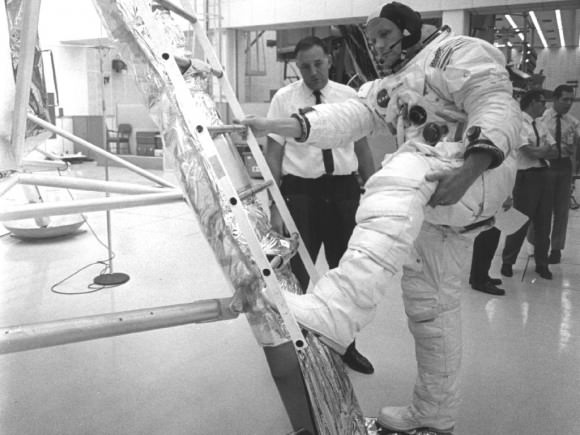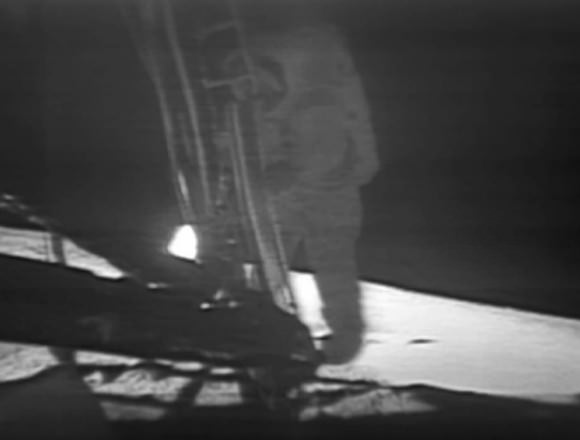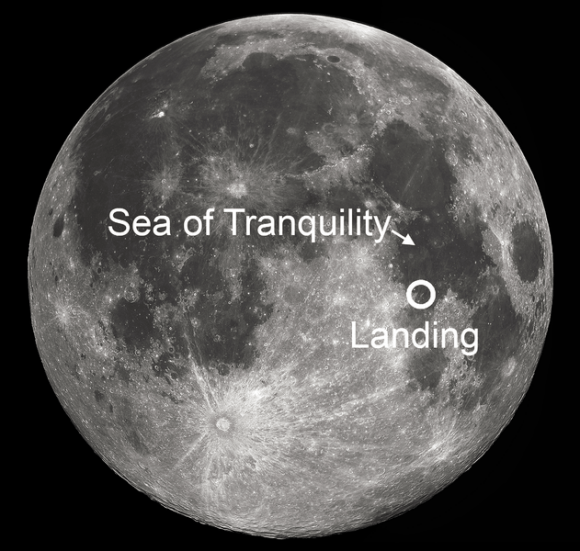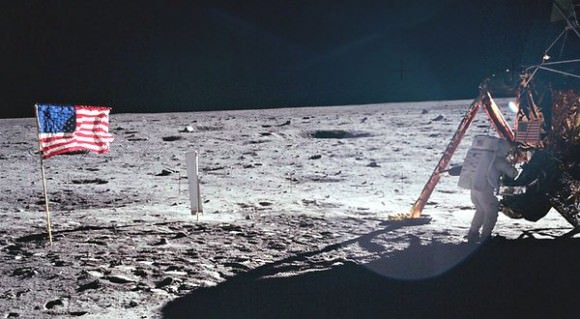Apollo 11 moonwalker Neil Armstrong died on Aug. 25, 2012 at age 82, and NASA has posted a video tribute with an original song “Tranquility Base” by songwriter Eric Brace. Fittingly, the video starts with a 1960’s era television set showing the first Moon landing… were you watching on a TV like that on July 20, 1969 when Neil took those first steps on the Moon?
The song begins:
“Tell me Neil, what you were thinking
With all of us watching you on the TV
Taking small steps and giant leaps and planting the flag
In a place no one had been.”
Apollo 11 F-1 Engine Finding Confirmed by Jeff Bezos on Eve of 1st Human Moonwalk

In a fitting testament to NASA’s momentous Apollo Moon Landing Program, NASA and billionaire Jeff Bezos confirmed today (July 19) the discovery of a powerful F-1 first stage engine component from the Saturn V moon rocket that launched three American astronauts on the historic journey of Apollo 11 to land the first two humans on the Moon on July 20, 1969.
“On the eve of the 44th moonwalk anniversary, the Bezos Expedition confirms an Apollo 11 Saturn V F1 engine find,” NASA officially announced on its websites just moments ago today, July 19.
Apollo 11 commander and NASA astronaut Neil Armstrong, was immortalized forever when he first set foot on the moon 44 years ago tomorrow (July 20, 1969), followed minutes later by the lunar module pilot, NASA astronaut Buzz Aldrin.
The Saturn V rockets first stage was powered by a cluster of five F-1 engines – a technological marvel and the most powerful single-nozzle, liquid-fueled rocket engine ever developed.
“44 years ago tomorrow Neil Armstrong stepped onto the moon, and now we have recovered a critical technological marvel that made it all possible,” says Bezos on his Expedition website today.
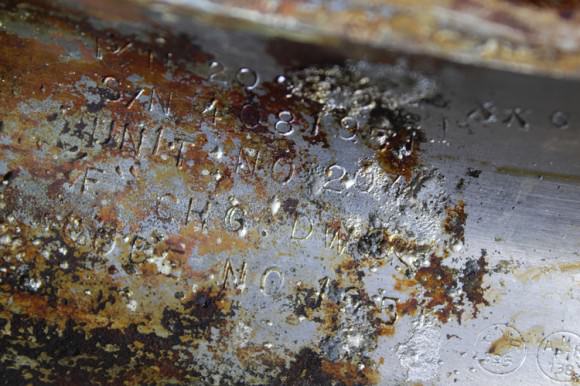
Bezos, founder and Chief Executive Officer of the aerospace company Blue Origin and Amazon.com, originally announced the discovery and recovery of significant components of two flown F-1 engines amongst a field of twisted wreckage from the floor of the Atlantic Ocean in March of this year, aboard the Seabed Worker at Port Canaveral, Florida, along with a treasure trove of other major Saturn V components hauled up from a depth of almost 3 miles.
“We brought back thrust chambers, gas generators, injectors, heat exchangers, turbines, fuel manifolds and dozens of other artifacts – all simply gorgeous and a striking testament to the Apollo program,” wrote Bezos in a update this morning, July 19.
But until today, the engines exact identification remained elusive because of decades of severe seabed corrosion and their fiery, destructive end upon plunging and smashing unimpeded onto the ocean’s surface.

Conservators from the Kansas Cosmosphere and Space Center in Hutchinson, Kansas worked painstakingly since March to identify the F-1 engine parts.
“Today, I’m thrilled to share some exciting news. One of the conservators who was scanning the objects with a black light and a special lens filter has made a breakthrough discovery – “2044” – stenciled in black paint on the side of one of the massive thrust chambers, says Bezos.
“2044 is the Rocketdyne serial number that correlates to NASA number 6044, which is the serial number for F-1 Engine #5 from Apollo 11. The intrepid conservator kept digging for more evidence, and after removing more corrosion at the base of the same thrust chamber, he found it – “Unit No 2044” – stamped into the metal surface.”

Apollo 11 launched to the Moon on July 16, 1969 from Launch Complex 39-A at the Kennedy Space Center in Florida.
Armstrong and Aldrin landed on the Sea of Tranquility inside the Lunar Module. They took a single lunar excursion and spent 2 hours and 11 minutes as the first two men to walk on the moon. They stayed on the moon for a total of 21 hours and 36 minutes before blasting off for the journey back home to Earth.
Armstrong suddenly passed away nearly a year ago on August 25, 2012 at age 82 – read my stories, here and here.
Aldrin is still active and strenuously advocating for starting human expeditions to the Red Planet.
He outlined his exploration concepts in a newly published book titled – “Mission to Mars.”
The five F-1 engines used in the 138-foot-tall Saturn V first stage known as the S-IC generated 7.5 million pounds of liftoff thrust, or some 1.5 million pounds each. They stand 19 feet tall by 12 feet wide. Each one weighs over 18,000 pounds and was manufactured by Rocketdyne.
The F-1 had more power than all three space shuttle main engines combined. They burned a mixture of liquid oxygen and kerosene fuel for two-and-one-half-minutes, carrying the Saturn V to an altitude of some 36 miles.
Altogether, six Apollo Moon landing flights boosted by Saturn V’s sent a total of 12 humans on moon walking expeditions to Earth’s nearest neighbor during the 1960s and 1970s.
“This is a big milestone for the project and the whole team couldn’t be more excited to share it with you all,” Bezos wrote.
Bezos’ Blue Origin firm is also working to develop a commercial rocket and ‘space taxi’ to finally resume launching American astronauts back to low Earth orbit from American soil after a multi year gap.
More than four decades have passed since the last humans traversed the lunar surface in December 1972 during NASA’s Apollo 17 moon landing mission.
After all that time, the F-1 may yet live again.
NASA is now working on an upgraded F-1 to power a future variant of the new SLS heavy lift booster under development and intended to launch humans aboard the new Orion crew capsule back to the Moon and to deep space destinations including Asteroids and Mars.
NASA’s robotic exploration of the moon continues this year with the blastoff of the LADEE Lunar observatory on Sept. 6 from NASA’s Wallops Island facility in Virginia.
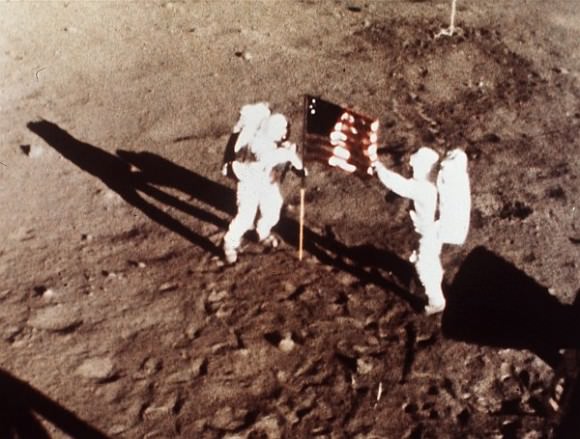
The Epitome of Cool: Neil Armstrong and David Scott, 1966

So, you’ve just endured a harrowing experience where your orbiting spacecraft has gone wildly out of control. You somehow — while undergoing the incredible, vertigo-inducing G-forces of your spinning spacecraft — figure out a plan, undock your spacecraft from another spacecraft and abort your original mission.
Six and a half orbits and ten hours and 44 minutes after you’ve thunderously launched into space, you violently re-enter Earth’s atmosphere and splash down in a pitching ocean. Obviously, you have to throw up, and so does your crewmate. But there’s just one air sickness bag.
But by the time the rescue crew has arrived you’ve donned your sunglasses and look as cool as a cucumber.
That’s Neil Armstrong and Dave Scott’s experience during the Gemini 8 mission.
The epitome of cool.
Neil Armstrong Didn’t Lie About First Words on the Moon, Historian Says
A small controversy has erupted over Neil Armstrong’s first words as he stepped on the Moon’s surface and how he came to say them.
Armstrong had always admitted that while he had been thinking about what to say during his first steps for quite some time before the Apollo 11 mission, he didn’t actually decide on his words until just after landing on the Moon, while waiting to exit the lunar module. In a new BBC documentary, the astronaut’s brother Dean Armstrong says the two discussed the statement months earlier, and that Neil gave Dean a handwritten note showing him the famous quote, “That’s one small step for (a) man, one giant leap for mankind.”
But apparently some people (and writers) have gotten a bit confused, thinking that Armstrong said he thought up the words on the spot, and recent headlines have screamed that “Armstrong Lied” about the quote.
Not so, says says space historian and author Andrew Chaikin, who wrote the book, “A Man on the Moon,” and interviewed Armstrong several times.
“I was distressed to see recent news stories claiming that Neil Armstrong lied to the world about when he made up his famous quote,” Chaikin said via email, and asked Universe Today to share the op-ed he wrote for Space.com.
In the op-ed piece, Chaikin cut to the chase, saying, “Let’s get one thing straight right now: Neil Armstrong was not a liar.” … “The problem, in some people’s minds, is that this seems to conflict with Neil’s own statements over the last 40 years about when and where he composed what became an immortal sentence when he took his first step onto the Moon,”
But it does not contradict history at all.
Chaikin notes that in Neil Armstrong’s first public statement about the famous quote at a post-flight press conference on Aug. 12, 1969, he said, “I did think about it. It was not extemporaneous, neither was it planned. It evolved during the conduct of the flight and I decided what the words would be while we were on the lunar surface just prior to leaving the LM.”
And when Chaikin interviewed Armstrong in 1988 for the book “A Man on the Moon,” Armstrong said the same thing, and he also told that to his biographer James Hansen in 2003.
“It is simply not true, as several recent news articles have claimed, that Armstrong always said he composed the quote ‘spontaneously,’” Chaikin wrote in the op-ed. “It would have been completely out of character for Armstrong, who was thoughtful about nearly everything he said and did, to have offered such an important quote without thinking it through beforehand.”
Chaikin says that Dean Armstrong’s story just adds a little ambiguity. “Maybe Neil had more than one quote in mind at that point, and only shared one of them with his brother. Or maybe the quote he showed his brother was an early draft, but after all these years, Dean remembers seeing the final version. We’ll probably never know the answer.”
But in no way does it mean that Armstrong “fibbed” or “lied” to the public for 40 years.
This isn’t the first time the famous first words have been a bit controversial. While the “a” in “one small step for a man” wasn’t audible in the broadcast to the world, Armstrong always said he did speak that word. A 2006 audio analysis of the broadcast supported Armstrong.
Neil Armstrong passed away in August 2012.
Weekly Space Hangout – Sep. 20, 2012
Once again, it’s time for the Weekly Space Hangout – our round up of all the big space news stories that you should be aware of. This week we talked about the following interesting stories in space and astronomy:
- NASA Working on a Real Warp Drive
- Transit of Phobos Seen by Curiosity
- What Happened at Neil Armstrong’s Funeral
- Curiosity’s First Rock Target: Jake
- Furthest Galaxy Discovered
Contributors: Nicole Gugliucci, Ian O’Neill, Jason Major, Amy Shira Teitel, Nancy Atkinson
Host: Fraser Cain
We record the Weekly Space Hangout every Thursday morning live at 10:00 am Pacific / 1:00 pm Eastern as a live Google+ Hangout.
If you want to make sure you never miss an episode, put it into your calendar. Click here to see our next event on Google+.
Neil Armstrong Remembered in Memorial Service
Neil Armstrong, the first person to set foot on the Moon, was honored in a memorial service at the Washington National Cathedral on September 13, 2012. He was remembered as a quiet but strong hero who led mankind into space. Armstrong died last month at 82 following complications after heart surgery. He will be buried at sea in the Naval tradition today (Friday, September 14, 2012) at an undisclosed site.
“He embodied all that is good and all that is great about America. Neil, wherever you are, you again have shown us a way to the stars,” said Gene Cernan during the memorial. Cernan was commander of the Apollo 17 mission in 1972 and the last person to walk on the Moon.
If you missed watching it live, here is a video of the entire service. The National Cathedral was a fitting place to remember Armstrong, as it has one stained glass window, known as the Space Window, which has a piece of Moon rock presented by Armstrong and his Apollo 11 crewmates Buzz Aldrin and Michael Collins in 1974.
The recessional at the conclusion of a memorial service celebrating the life of Neil Armstrong at the Washington National Cathedral, Thursday, Sept. 13, 2012. Photo Credit:(NASA/Paul E. Alers) Click here to see a gallery of images from the service.
The Cathedral was filled with NASA officials, astronauts, and the general public who wanted to pay their respects to the man who displayed courage and grace under pressure that had made him exceptional, said NASA Administrator Charlie Bolden.
Cernan provided an example of Armstrong’s “cool under pressure” personality in recounting Armstrong’s response years ago when asked how he felt when he was landing on the Moon with only seconds of fuel remaining.
Cernan recalled Armstrong saying, “Well, when the gauge says empty we all know there is a gallon or two left over,” which drew laughter from the crowd.
At the end of the service, Bolden presented Armstrong’s wife, Carol, with the flag that had flown at half-staff over the NASA Johnson Space Center in Houston on August 25, the day Armstrong passed away.
Sharing Memories of Neil Armstrong – Photo Gallery
Image Caption: Neil Armstrong at the Kennedy Space Center (KSC) Saturn V Exhibit (Control Room) for the 30th Anniversary of Apollo 11 on July 16, 1999. Credit: John Salsbury
In tribute to Neil Armstrong, first human to grace another world here’s a new gallery of unpublished photos to enjoy as shared by my good friend – space photographer John Salsbury.
Armstrong was the first person to walk on the Moon as the commander of NASA’s Apollo 11 flight in 1969. Neil passed away on August 25, 2012 at age 82.
Salsbury writes, “I was fortunate enough to be at the KSC Saturn Exhibit for this photo op of the 30th Anniversary of Apollo 11 on July 16, 1999. These photos were the best I could get using my Minolta XGM 135 mm and Kodak 1000 with no flash.”
On Friday August 31, a private memorial service was held in Cincinnati, Ohio (photos below) to pay tribute to Neil Armstrong. Numerous dignitaries attended the service including his two surviving crewmates Buzz Aldrin and Michael Collins
Image Caption: Neil Armstrong Memorial. A memorial tribute from the Smithsonian is seen at the entrance of a private memorial service celebrating the life of Neil Armstrong, Aug. 31, 2012, at the Camargo Club in Cincinnati. Armstrong, the first man to walk on the moon during the 1969 Apollo 11 mission, died Saturday, Aug. 25. He was 82. Photo Credit: (NASA/Bill Ingalls)
NASA released this statement from NASA Administrator Charles Bolden
“Today, we pay tribute to a pioneering American; an explorer, a patriot and an individual who, with ‘one small step,’ achieved an impossible dream. Family, friends and colleagues of Neil’s gathered to reflect on his extraordinary life and career, and offer thanks for the many blessings he shared with us along the way.
His remarkable achievements will be forever remembered, and his grace and humility will always be admired. As we take the next giant leap forward in human exploration of our vast universe, we stand on the shoulders of this brave, reluctant hero. Neil Armstrong’s first step on the moon paved the way for others to be the ‘first’ to step foot on another planet. We have an obligation to carry on this uniquely American legacy.
A grateful nation offers praise and salutes a humble servant who answered the call and dared to dream.”
Read my earlier story about the passing of Neil Armstrong; icon for the ages and hero to all who dare mighty deeds – here
See more photos from the Neil Armstrong Memorial service in Ohio held on Aug. 31 – here
Image Caption: Neil Armstrong at the Kennedy Space Center (KSC) Saturn V Exhibit for the 30th Anniversary of Apollo 11. Credit: John Salsbury
Image Caption: Apollo astronauts Neil Armstrong, Buzz Aldrin, Gene Cernan,& Walt Cunningham gather at KSC for the 30th Anniversary of Apollo 11 – Saturn 5 Exhibit Control Room on July 16, 1999. Credit: John Salsbury
Image Caption: Apollo astronauts Neil Armstrong, Buzz Aldrin, Gene Cernan,& Walt Cunningham gather at KSC for the 30th Anniversary of Apollo 11 – Saturn 5 Exhibit Control Room on July 16, 1999. Credit: John Salsbury
Image Caption: Apollo astronauts Neil Armstrong, Buzz Aldrin, Gene Cernan,& Walt Cunningham gather at KSC for the 30th Anniversary of Apollo 11 – Saturn 5 Exhibit Control Room on July 16, 1999. NASA Launch Commentator Lisa Malone holding mike. Credit: John Salsbury
Image Caption: Apollo 11 Astronauts Michael Collins, left, and Buzz Aldrin talk at a private memorial service celebrating the life of Neil Armstrong, Aug. 31, 2012, at the Camargo Club in Cincinnati. Armstrong, the first man to walk on the moon during the 1969 Apollo 11 mission, died Saturday, Aug. 25. He was 82. Credit: NASA/Bill Ingalls
Image Caption: Neil Armstrong Memorial – Members of the U.S. Navy Ceremonial Guard from Washington, D.C., present the Colors during a memorial service celebrating the life of Neil Armstrong, Friday, Aug. 31, 2012, in Cincinnati. Armstrong, the first man to walk on the moon during the 1969 Apollo 11 mission, died Saturday, Aug. 25. He was 82. Photo Credit: (NASA/Bill Ingalls)
Let’s Send Neil Back To The Moon
As a native-born and life-long resident of Ohio, I have lived in the shadow of Neil Armstrong all my life. I visit Wapokenta every few years for two simple reasons – I love the Armstrong Museum and I feel a need to pass that heritage on to children, grandchildren and visiting friends. Of course, I was crushed when I read of his death. I would have given anything to have had Armstrong’s autograph on my original Apollo landing newspapers, or even just to have seen the man. He was a humble hero… and this is the quality that I loved most about him. However, Neil Armstrong and his quiet ways didn’t just impact my life. He touched us all.
“Early on Sunday morning here in Australia I got the news I never wanted to hear.” says Dave Reneke of Australia. “I was in the middle of a radio interview on a local station when they cut in with the news that Neil Armstrong had passed away. “What?? What are you telling me…Neil’s dead!!” I cut the interview short because I simply couldn’t go on.
Neil Armstrong wasn’t just an American hero; he belonged to the entire world. Kids wanted to be like him. Men looked up to him and every woman wanted to be Mrs. Neil Armstrong. My world had just collapsed and I didn’t know what to do.
A humble man who, as a kid, only ever wanted to fly, Neil went on to pilot the famous X-15 rocket plane, fly dozens of dangerous missions during the Korean War and later travel in space with Dave Scott on the Gemini 8 mission in 1966. He was unknowingly paving the way for his ultimate destiny to be the first man to walk on the Moon a mere 3 years later.
There will never be another event like this. If anything epitomises the twentieth century it was the first Moon landing. Our first steps on another world. Those of us who witnessed it remember where they were at the time, just as we did when Elvis died and Kennedy was assassinated. Tragedy imprints, indelibly!
For 12 hours during and throughout that moon walk period there was virtually no crime around the world. One in six human beings were watching the moon landing on TV, even the crims, and listening on radios. For a moment in time we were united – we knew, we just knew we were witnessing one of the greatest events in history unfold right before our very eyes.
You only get one shot at this. Only one person can walk on the moon for the first time. It took guts – the ‘right stuff!’ Neil gave them a 50/50 chance of getting to the Moon and getting back. Nasa’s odds were about the same. They were both 38 years old with families and a whole lifetime in front of them, but they went.
I was lucky enough to be invited to spend the morning with Buzz Aldrin at his home in California in 2008, prior to writing a story about the upcoming 40th anniversary of Apollo 11. I remember asking Buzz what concerned them the most, what was the one thing they were concerned about and feared the most.
Both he and Neil had two days cooped up in a small capsule to think about that. He paused, looked up and surprised me by saying they were very aware they were being watched. “We knew that everything we did and everything we said was being recorded for future history,” Buzz said. “It was on our minds constantly.”
OK, it’s over. Neil Armstrong’s name will live on from this day forward. He’s gone beyond the term legend. In the annals of history he’ll be seen as a giant, the Wilbur Wright of our time. Hundreds of years from now kids in a future classroom will be learning about Neil Armstrong, as we studied ancient history in our day.
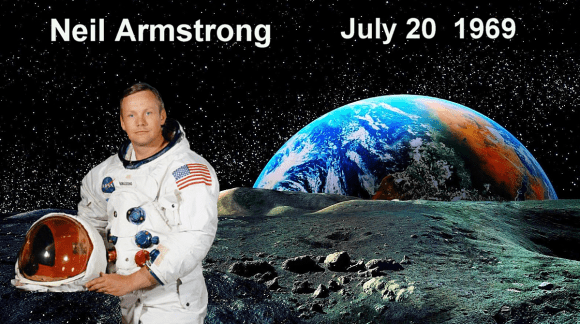
But hang on, do we leave it all here? Is this where the story ends? Let’s do something about it, something quite radical but completely sensible. Let’s send Neil Armstrong back to the Moon! Not literally but posthumously. Let’s start a movement that will reverberate back to NASA, to the white house and engage a lobby group to have Neil Armstrong’s ashes interred on the Moon.
I’m proposing a monument to be built on the Sea Of Tranquillity, on the spot where Neil and Buzz walked and, if there’s no national burial planned, place his ashes there. An eternal symbol and testament to human accomplishment – as Neil put it, the place where men from planet Earth first set foot on the Moon, and came in peace for all mankind.
Let it be slated for the first Moon return mission, by any country or private consortium. A stone minimally inscribed with a simple message telling the story for future generations. The blood, sweat, tears and spirit of countless thousands who worked on the Moon missions would be indelibly imprinted on it. Even the words ‘Neil and Buzz were here’ would satisfy me.
We’ve got the ‘Monument to a Century of Flight’ located at the Aycock Brown Welcome Centre at milepost 1.5 in Kitty Hawk, NC, the Smithsonian cradles flight history and the ashes of people like Gene Rodenberry, James Doohan et al circle the earth in tributary gestures.
Neil’s remains would be in good company on the Moon sharing the eternal silence with the ashes of Eugene Shoemaker. If you just asked “who” Google the name, it’s a great story. Folks, this is not something we need to do, it’s something we should do!”
The author of this narrative would like to hear any feedback, especially if you’re in a position to help make this happen. Contact Dave Reneke, writer and publicist for Australasian Science magazine via his webpage www.davidreneke.com or email [email protected]
Walk on the Moon with Neil Armstrong in a Beautiful Interactive Panorama
Danish photographer Hans Nyberg has created several interactive panoramas, including a new one featuring the Curiosity rover. But today, we’d like to focus on one he created for Apollo 11, allowing you walk along with Neil Armstrong’s steps on the Moon. “Armstrong only appears in a few images on the Moon, as he was the one who took almost all images, Nyberg writes on his website. “But his shadow is there and in the helmet reflection in the famous image of Buzz Aldrin you see him.”
It works best to view the panorama in full screen; click the thumbnail images at the top to see the various still images.
Continue reading “Walk on the Moon with Neil Armstrong in a Beautiful Interactive Panorama”
Neil Armstrong; 1st Human on the Moon – Apollo 11, Tributes and Photo Gallery
Image Caption: On the Lunar Surface – Apollo 11 astronauts trained on Earth to take individual photographs in succession in order to create a series of frames that could be assembled into panoramic images. This frame from fellow astronaut Buzz Aldrin’s panorama of the Apollo 11 landing site is the only good picture of mission commander Neil Armstrong on the lunar surface. Credit: NASA
In memory of Neil Armstrong, First Man to set foot on the Moon, here’s a summary of Apollo 11 highlights and a collection of some tributes and photos to celebrate his life and the indelible inspiration he gave to current generations and all those yet to come to take up the noble torch for science and exploration. He became an everlasting icon for the ages when he took, “one giant leap for mankind”, and accomplished one of the greatest feats in human history.
Armstrong passed away at age 82 on Saturday, August 25, 2012 due to complications from heart bypass surgery.
Neil Armstrong was the commander of the three man crew of Apollo 11, which included Buzz Aldrin and Michael Collins.
Apollo 11 Crew. The Apollo 11 lunar landing mission crew, pictured from left to right, Neil A. Armstrong, commander; Michael Collins, command module pilot; and Edwin E. Aldrin Jr., lunar module pilot. Credit: NASA
The trio blasted off on their bold, quarter of a million mile moon mission from Cape Canaveral, Florida on July 16, 1969 to fulfill the lunar landing quest set by President John F. Kennedy early in the decade.

Armstrong and Aldrin safely touched down at the Sea of Tranquility on the lunar surface on July 20, 1969 as hundreds of millions across the globe watched in awe and united in purpose.
“Houston, Tranquility Base here. The Eagle has landed !,” Armstrong called out and emotional applause erupted at Mission Control – “You got a bunch of guys about to turn blue.”
Armstrong carried all of humanity with him when he stepped off the footpad of NASA’s Apollo 11 Lunar Module and became the first representative of the human species to walk on the surface of another celestial body.
His first immortal words,
“That’s one small step for [a] man, one giant leap for mankind.”
During their 2 ½ hours moonwalk Armstrong and Aldrin unveiled a plaque on the side of the lunar module. Armstrong read the words;
“Here men from the planet Earth first set foot upon the moon. July 1969 A.D. We came in peace for all mankind.”
The duo collected about 50 pounds (22 kg) of priceless moon rocks and set out the first science experiments placed by people on another world.
Altogether Armstrong and Aldrin spent about 21 hours on the moon’s surface. Then they said goodbye to the greatest adventure and fired up the LM ascent engine to rejoin Michael Collins circling above in the Apollo 11 Command Module.
Tributes to Armstrong have been pouring in – He is often described as a reluctant hero who gave credit to others.
“Armstrong, the lunar Adam,” wrote Virginia Adams
Armstrong and Aldrin plant the US flag on the Lunar Surface, July 1969. Credit: NASA
In a statement, NASA Administrator Charles Bolden said in part,
“As long as there are history books, Neil Armstrong will be included in them, remembered for taking humankind’s first small step on a world beyond our own.
“Besides being one of America’s greatest explorers, Neil carried himself with a grace and humility that was an example to us all. When President Kennedy challenged the nation to send a human to the moon, Neil Armstrong accepted without reservation.
“As we enter this next era of space exploration, we do so standing on the shoulders of Neil Armstrong. We mourn the passing of a friend, fellow astronaut and true American hero.”
Armstrong’s family released a statement that said in part;
“We are heartbroken to share the news that Neil Armstrong has passed away following complications resulting from cardiovascular procedures.
“Neil was our loving husband, father, grandfather, brother and friend.
“Neil Armstrong was also a reluctant American hero who always believed he was just doing his job. He served his Nation proudly, as a navy fighter pilot, test pilot, and astronaut. He also found success back home in his native Ohio in business and academia, and became a community leader in Cincinnati.
“For those who may ask what they can do to honor Neil, we have a simple request. Honor his example of service, accomplishment and modesty, and the next time you walk outside on a clear night and see the moon smiling down at you, think of Neil Armstrong and give him a wink.”
“He was the best, and I will miss him terribly,” said Michael Collins, Apollo 11 command module pilot.
Buzz Aldrin, Apollo 11 lunar module pilot, released a statement that said in part,
“I am very saddened to learn of the passing of Neil Armstrong today. Neil and I trained together as technical partners but were also good friends who will always be connected through our participation in the Apollo 11 mission. Whenever I look at the moon it reminds me of the moment over four decades ago when I realized that even though we were farther away from earth than two humans had ever been, we were not alone. Virtually the entire world took that memorable journey with us.”
More photos of Neil Armstrong and crew at NASA here
Armstrong training on an X-15. Credit: NASA
Training for Apollo 11 on the Lunar Module. Credit: NASA
The Apollo 11 crew leaves Kennedy Space Center’s Manned Spacecraft Operations Building during the pre-launch countdown. Mission commander Neil Armstrong, command module pilot Michael Collins, and lunar module pilot Buzz Aldrin prepare to ride the special transport van to Launch Complex 39A where their spacecraft awaited them. Liftoff occurred at 9:32 a.m. EDT, July 16, 1969. Credit: NASA
Apollo 11 liftoff from Pad 39 at the Kennedy Space Center on July 16, 1969. Credit: NASA
Neil Armstrong about to become the first person to set foot on the lunar surface -TV camera view. Credit: NASA


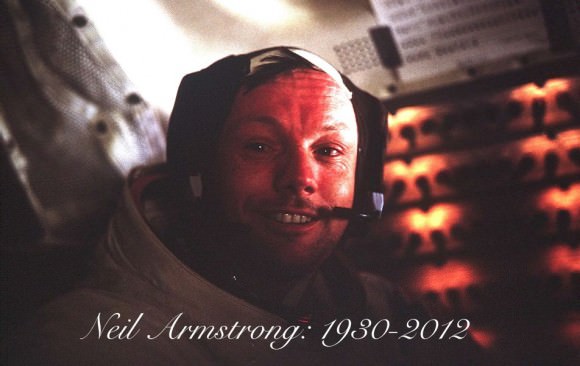
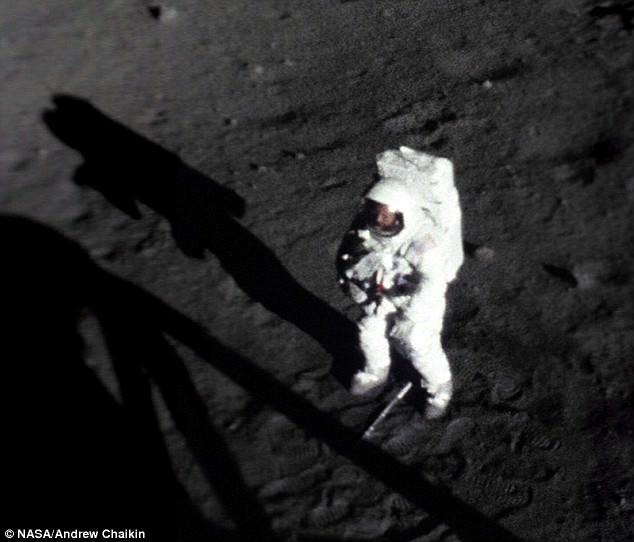
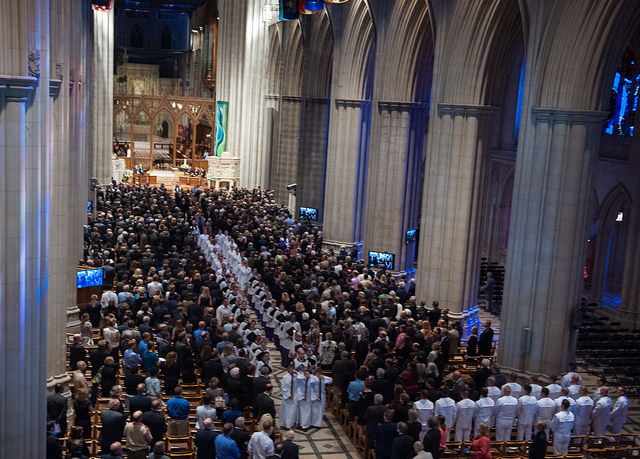


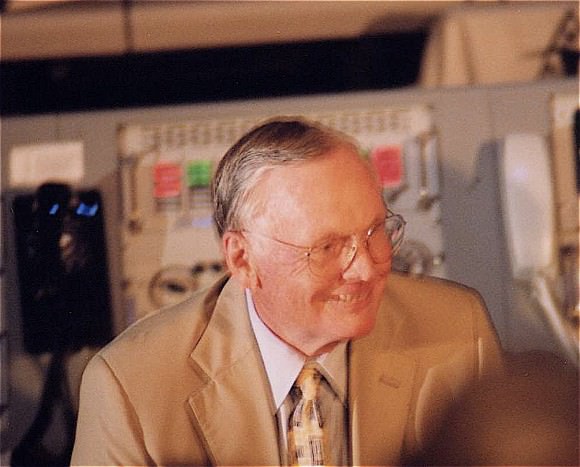
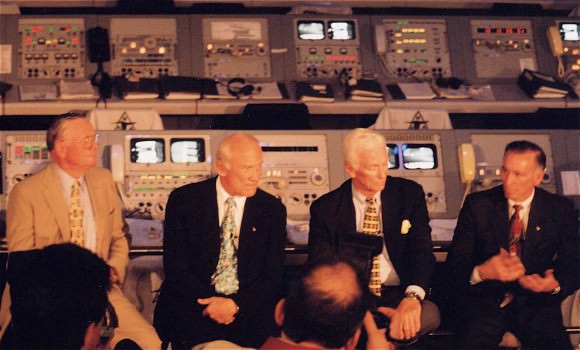



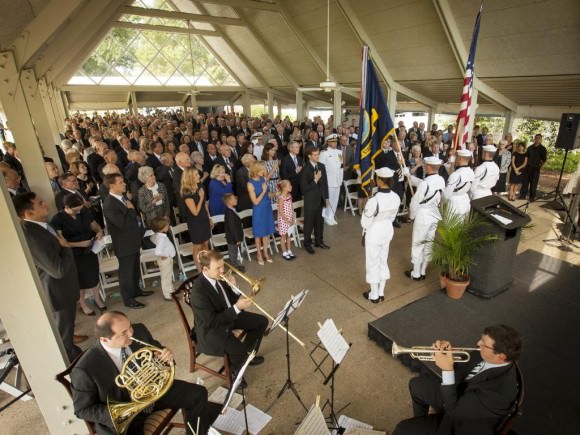


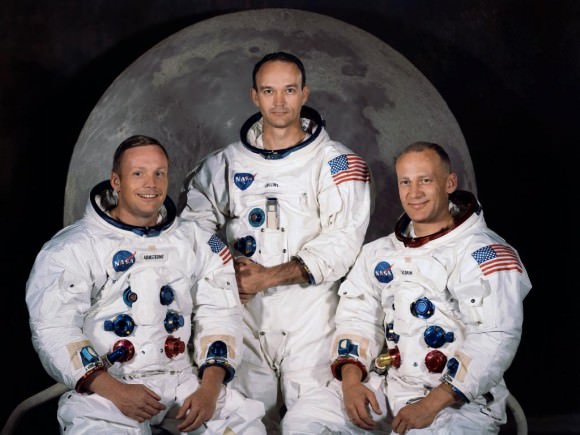


![246074main_E60-6286_1600_1024-768[1]](https://www.universetoday.com/wp-content/uploads/2012/08/246074main_E60-6286_1600_1024-7681-580x435.jpg)
